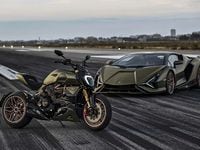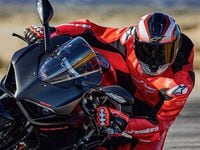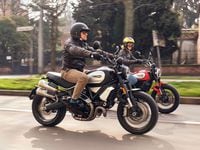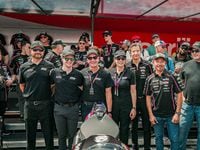Aprilia’s stylish RS 660 middleweight twin sportbike was shown in prototype at EICMA 2018, but its appearance does not reveal all that’s new in its combination of qualities. The long-serving 600 middleweights we’ve seen before have now been soundly rejected in the present marketplace for three reasons:
- Too expensive—they had become pricey miniature Superbikes, designed to win Supersport races in the hands of professional athletes.
- Too uncomfortable—the racer riding position is fun for a 10-minute let’s pretend, but a pain in the long run.
- Too specialized—focus group testing always shows that motorcyclists enjoy twist-and-go torque at any rpm, not a power-genie who explodes out of his bottle only above 10,000 rpm.
This leaves manufacturers wondering what new kinds of products can sustain their business. An alternative is a lighter, simpler, and frankly cheaper sportbike that is easier to ride well, powered by a versatile parallel-twin engine that can power more than one model.
Motorcycle designer Miguel Galluzzi, at Piaggio’s Advanced Design Center in Pasadena, California, spoke directly about the RS 660′s conception (Piaggio, an Italian company founded in 1884, owns Vespa, Aprilia, Gilera, and Guzzi).
“Six years ago, being at the office late, we discussed RSV4 and its million horsepower. Who needs all this? What if we cut this V-4 in half?
“Discussion began about something more down-to-earth—but recognizing that we are still Aprilia, still Italian. How about a lightweight, more affordable sportbike that can do a lot of things? Not just to have a big-dollar motorcycle in your garage with tire warmers on it, only to look at.
“The present affordability problem means we need a reset—for some riders the monthly insurance payment was more than the monthly payment for the bike!
“This 660 began as a simple 500. Is our plan to make a cheap bike, like the Indians do? We keep in mind the new buyer. The riding position of 660 is in the middle—the bars are higher than on RSV4, the pegs are lower. This (change) is not just us, it is worldwide.
“Do we need more (aero) or less? We are seeing in MotoGP the largest changes in (motorcycle) shape in a long time.”
He was referring to the downforce winglets, spoons, and scoops that have appeared in recent seasons. The present shape of sports motorcycles was set in 1958 when the FIM ended the racing era of full “dustbin” streamlining. The whole front wheel and the aft 180 degrees of the rear wheel were required to be visible from both sides, and streamlining ahead of a vertical plane drawn through the front axle was forbidden.
Galluzzi spoke with admiration of the dynamic early US Superbike era (1975–‘82) when improvised race bikes evolved week by week before our eyes: “The technology of the past was low, but the thinking was very high.”
Finding a way forward in our much-changed motorcycle market requires high thinking.
“Aprilia is the discussion in the company canteen—every department together. Now there is a digital way of working: Send a 3-D file from the US in the p.m., Italy sees it in the a.m. This can be done in detail—in the moment.
“Look at the picture today, look at the picture tomorrow, to be predictive of future customers. Americans are looking for Italian design. Okay, have the idea now, but when will it make (market) sense? We fight about what is to be done, and there may be screaming. But the product is central.”
The result of these politics is a light (372 pounds, dry), compact (54.5-inch wheelbase), and easy-to-ride (very broad, flat torque) new kind of sportbike powered by a liquid-cooled parallel-twin engine of 81.0 x 63.9mm bore and stroke. It is carried in a bolted-together cast aluminum chassis, all in a faired MotoGP style.
The concepts of product planners are made real by engineers. Two weeks after speaking with Galluzzi, we teleconferenced with a group of Aprilia engineers—Paolo Nesti, head of powertrain, Francesco Mennella, chief engineer motorcycle powertrain, and Piero Soatti, head of body and chassis. We were told the targets for this 660 were “light weight, not extreme for the rider, not so ‘flat’ as the competition, with sharp throttle response, quick direction changing, narrow width, and good corner clearance.”
In the era just ended, buyers did seek extremes—big sportbikes that were unhappy below 10,000 rpm and barely off-idle at highway speed, or tall 550-pound Patagonia-ready ADV rigs, plus the costumes and riding posture required to look like a player. Riding today is less about looking the part than about versatility, freedom of choice. Despite the virus epidemic and depressed economy, CW’s research and dealer experience are showing increased interest in motorcycling. The market, as Galluzzi noted, seeks a more comfortable riding position, with across-the-range engine torque—twist-and-go at any revs—is now valued more highly than extreme-but-seldom-usable horsepower or speed.
The need for a price reset dictates simplicity—reduced vehicle parts counts, use of parts already in production, elimination of exotic materials, and focus on versatile engines capable of powering models in more than one category of riding.
Sign up here to receive our newsletters. Get the latest in motorcycle reviews, tests, and industry news, subscribe here for our YouTube channel.
Aprilia has something of great value in the refined combustion chambers and ports of its RSV4 Superbike, so it made sense to share them with RS 660, giving it 100 hp at a moderate 10,500 rpm. This is strong performance from a 40.2ci parallel twin, especially with a high and very wide 21st century torque curve, giving outstanding drivability (the rev limiter steps in at 11,500). This is torque so flat that it’s hard to find a peak, for the quoted maximum of 49.4 pound-feet varies only a percent or so between 8,500 and 10,500. Ninety percent of that is available from 6,250 and 80 percent from 4,000. That is a torque plateau, not a curve. Flat is good.
Power so easy to use makes us better riders; with it we devote less concentration to constant shifting. To engineer it, valve duration (the number of degrees valves are open per cycle) must be reduced so that at mid- and low rev torque is not lost by rising pistons pumping 25 percent of the charge back out through late-closing intake valves (because there’s not enough intake velocity at lower revs to prevent this back-pumping). To recover flow lost by short timing, valves must open to greater lifts. Both of these changes (shorter timing and higher lift) require that valves accelerate and decelerate faster—much as they do in pure racing engines. Three points make it possible to do this:
- Peaking this engine at a moderate 10,500 rpm rather than the 14,000 to 16,000 expected of potential World Superbike winners.
- Valve control techniques learned in years of World Superbike racing.
- Use of four smaller, lighter valves per cylinder, rather than two larger, heavier ones.
Riders used to assume that high performance and being hard to ride were natural, even necessary partners. That may have been true in the past, but no more. All of us, from novice to MotoGP pro, ride better when our machine gives us confidence.
Aprilia engineers told us they sought “to create an engine family with dedicated components for specific applications.” By changing cams, throttle bodies, oil sump, and electronics, the same base engine can power the RS 660 and the off-road Tuareg, giving each the kind of performance its role requires. Further versatility can be seen in the elongated swingarm mounting lugs on the back of the 660′s gearbox, permitting vertical adjustment of the pivot location for swingarms with different droop angles or lengths.
Why a parallel twin? The engineers say this lowers tooling cost and produces a compact engine whose simple shape more easily fits wherever the application requires. For example, lack of a V-engine’s rear cylinder(s) expands the choices for rider seat location. Think of this bike as a modern expression of what created the classic British twin. Power is 2.5 times greater than that of the Triumph Bonneville of the 1960s, but with very similar weight, on/off-road “mission versatility,” and the responsive performance some call “invitation to ride.”
Older readers recall the considerable vibration of British twins, which set their front wheels shaking forward and back at idle. To be compatible with the RS 660′s aluminum chassis the engine’s primary shaking force is canceled by a crank-speed balance shaft with two eccentric weights. To counter secondary shaking force (which arises from the twice-per-revolution changes in connecting-rod angle) the two crankpins are set at 270 degrees. By opposing rather than adding those secondary forces, this cancels them. The result is humane smoothness for all-day riding. That 270-degree crankpin spacing also replaces the traditional drone of an even-firing parallel twin with the more muscular syncopated sound of a V-twin.
The engineers reminded us that engine smoothness allows elimination of the flex and uncertainty of rubber-mounted footpegs and bars. Look closely at older motorcycles lacking balance shafts and you will find rubber everywhere.
If Aprilia had powered this bike with RSV4 1100′s two front cylinders, displacement would have been 539cc, and reaching the RS 660′s 100 hp would have required 13,000 rpm. It’s easier to get wide, rideable power from more displacement than from more revs. Another useful result of the lower-revs approach is that this engine can use normal steel con-rods and valves rather than the pricey titanium alternatives that become necessary at the red end of the tach. High revs have a cost in friction too—World Superbike revs can push friction loss to 25 percent.
Narrow-skirted cast pistons are cooled by crankcase oil jets. We were told that “without those jets, (meeting) Euro 5 would be impossible.” Why? In engines, everything is interrelated. The hotter the pistons run, the farther down from the piston crown the rings must be located to keep them from sticking—when very hot lube oil polymerizes into gum. The farther down rings are located, the more piston-ring crevice volume there is, into which compression and combustion can force a surprising volume of unburned mixture. It later squirts back out to be detected as unburned hydrocarbons (UHC) in excess of the Euro 5 limit. As you might expect, shorter valve timings also help here, by limiting the time that both intake and exhaust valves are open together. Details, details.
An engine’s character (is it peaky? Is it a torquer?) is mainly determined by its cam timing, but its torque is strongly linked to compression ratio. This engine is able to operate safely at the high ratio of 13.5 for three reasons:
- Most riding takes place at part throttle, where detonation is less likely.
- The developed RSV4 port and combustion chamber shapes accelerate combustion, allowing it to “outrun” the heat-driven chemical processes that lead to detonation.
- Modern engines are given detonation detection systems that retard ignition timing if detonation is detected. If you do happen to get a tank of substandard gas (the lower the octane number, the more likely an engine is to detonate), this system provides electronic protection.
Only steel chassis could survive on the vibrating bikes of olden time, but with smooth balancer-equipped powerplants like that of the RS 660, aluminum structures like this cast aluminum chassis and swingarm live long, happy lives. Wheelbase is a quick-turning and short 54.5 inches, and the steering rake and trail are 24.3 degrees and 104.6mm (4.1 inches). Not so long ago, shorter trail numbers around 90mm were considered hot, so what’s changed? When manufacturers learned in the ’90s the importance of swingarm pivot height in preventing squat and front-end push during acceleration, they found that once that was right, a twitchy ultra-short trail became unnecessary.
The chassis is made in two main pieces, right and left, assembled by bolts (Harley’s LiveWire chassis is built in this way). Forget the brute force that was once necessary to force steel tube chassis into acceptable alignment after the welds cooled. Instead, machine the castings, bolt them together, and find everything in alignment. A look at the steering head shows clear MotoGP influence. A plastic forward shell structure supports the instruments and fairing. It also incorporates a ram-air intake that feeds MotoGP-style straight through the steering head, between the steering bearings and into the intake airbox.
This frame ends and attaches at the top of the gearbox—the swingarm pivots on the engine itself. The right-hand beam of the aluminum swingarm kinks upward in “banana” style to provide exit pipe clearance for a compact under-engine exhaust system.
As would be expected, the RS 660 carries the now-expected suite of electronic rider aids.
Earlier, Galluzzi had told us, “The front wheel can still be free (visible from both sides) but we can do a lot of things around it.” What might he mean? A 1973 conversation with two MIT aero professors may shed some light. During World War II, aircraft radar antennas were drag-producing dipole arrays. Researchers found that placing the dipoles in front of a flat surface reduced that drag. Just such a flat surface can be seen behind the front wheel of Peter Williams’ 1972 Norton racer. The flat surface, pushing a rounded stagnation zone of low-energy air in front of it, reduced the speed of airflow over the dipoles (or an unstreamlined motorcycle front wheel), considerably reducing drag.
Why bother with aero? Because motorcycles have surprisingly high drag for their size, resulting in fuel consumption that is often worse than that of economy autos. In a world concerned by global warming, high fuel consumption is a red flag to government regulators. Improved aero is a major tool in reducing fuel use.
In the past, manufacturers knew what to do at new-model time; it had been a constant formula for 30 years: Supersport, tour, cruiser, and off-road. That formula has now failed, so motorcycle manufacturers, one by one, are placing their bets on what the future motorcycle must be. Whose combination of price, style, and function will make the connection with riders?





















/cloudfront-us-east-1.images.arcpublishing.com/octane/B6M3WTRLFZGNXBEATNXPVGBBD4.jpg)
/cloudfront-us-east-1.images.arcpublishing.com/octane/4CMH3FI73BEM5D6MFYX42FLDSQ.jpg)
/cloudfront-us-east-1.images.arcpublishing.com/octane/RIHAPYNWU5H3XAOXNOPRWCBTQA.jpg)
/cloudfront-us-east-1.images.arcpublishing.com/octane/HU4NUBCL3VAFZA75VYRCMAUHVM.jpg)
/cloudfront-us-east-1.images.arcpublishing.com/octane/OB43AZK7TRA6XLZL5WRDVW2TDA.jpg)
/cloudfront-us-east-1.images.arcpublishing.com/octane/5G44Y3FXWNFSTEQKCA355PXOPU.jpg)

/cloudfront-us-east-1.images.arcpublishing.com/octane/XRI4GTLCVBA5NESASCBIR5LYQI.jpg)
/cloudfront-us-east-1.images.arcpublishing.com/octane/EF7566PXARGMBAOMLWTECYL3LE.jpg)





/cloudfront-us-east-1.images.arcpublishing.com/octane/3LASNXSWUZFFPISURDJF3OCWBU.jpg)
/cloudfront-us-east-1.images.arcpublishing.com/octane/2BHJKWUTBNBTLMQCKDNVEG6DKQ.jpg)
/cloudfront-us-east-1.images.arcpublishing.com/octane/MPHXIIV54NAU5L6E4SYZHCXVRM.jpg)



/cloudfront-us-east-1.images.arcpublishing.com/octane/WYXFHF4ZOBBTXELIZDB2FJXU64.jpg)
/cloudfront-us-east-1.images.arcpublishing.com/octane/K5FNV7ONUVDXJJ2H5BIWUGBGTI.jpg)
/cloudfront-us-east-1.images.arcpublishing.com/octane/MGVKP5VTNJHQ7FWNAHIWX4OHO4.jpg)
/cloudfront-us-east-1.images.arcpublishing.com/octane/6JEYTSIZQRHPJAVVPRLWZU63UM.jpg)